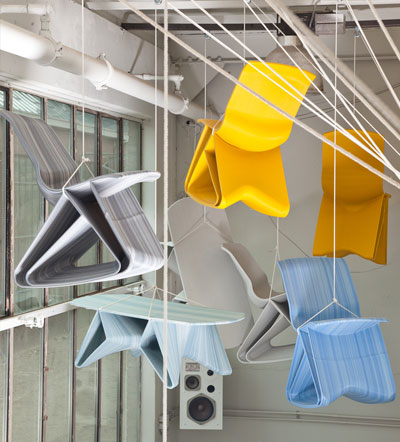
Workshop © Delfino Sisto Legnani

Just a few weeks ago, Dutch designer Dirk Vander Kooij presented the latest iteration of his graduation project,
Endless Flow, at Milan Design Week. His furniture, a collection of ergonomic, hollowed-out chairs and tables all made of the same candy-colored ribbed plastic, appears minimal but thoughtful, designed with the human body in mind. But the Endless process is really a globally-minded step towards sustainability. Vander Kooij employs a repurposed industrial machine to three-dimensionally print each chair, table, and lamp one by one, squeezing out a thin string of liquid plastic in layers like a soft-serve machine. Every piece is made of a single, coiled, “endless” string.
The practical benefits of the Endless process are many: there’s no casting mold involved, so there’s no discarded material. The chairs are made one at a time, so mistakes aren’t replicated across batches. And perhaps most importantly, the method uses 100% recycled plastic (Vander Kooij’s preferred medium is used refrigerator interiors). But from a designer’s point of view, the grace note of Endless Flow is that it allows the printer to watch a piece of furniture coming into existence, and to tweak it even as it is being created. Material waste is, after all, the product of a misplaced idea – Vander Kooij aims to cut down on intellectual waste as well.
(more…)
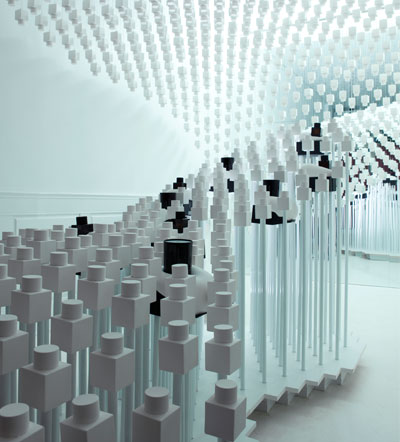
Odin x Snarkitecture 330 East 11th Street New York, NY

The bar for gratuitous pop-up shop gimmickry was set pretty high last year, sometime between Nicola Formichetti’s prism walls and Tommy Hilfiger’s temporary beach house. That makes Odin New York’s new pop-up, a 350 ft² pristine white cube dedicated to its Fragrances and Home Fragrances line, all the more refreshing. Odin teamed with design provocateurs Snarkitecture to create an interior based on the brand’s signature black-on-black bottle. Instead of display cases, the store is filled with two cascading waves of white cement casts of the Odin bottle, one emanating from the floor and one from the ceiling. Just a few real products are scattered among the white clones, instantly visible for their contrasting color but, oddly, almost like negative space instead of the main attraction. It’s certainly a unique way of selling products.
Though known as a men’s lifestyle brand, the fragrance collection offers six unisex scents and four candles for the home. The pop-up is open for the next six weeks.
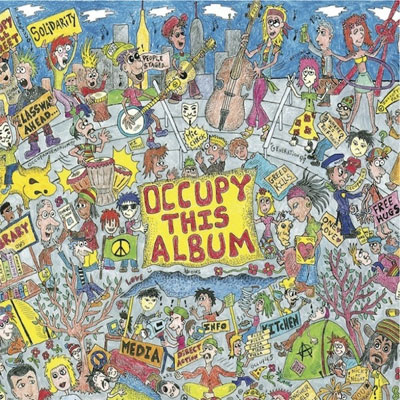

As Occupy Wall Street prepares for a warm-weather remobilization, three producers are putting the finishing touches on the movement’s first artistic endeavor. Occupy This Album, out this spring, includes tracks from nearly 50 artists and will use its proceeds to sustain the Occupy protests. Though the album was able to make headlines by securing stars like Yoko Ono, Tom Morello, and Crosby & Nash, the idea was inspired by the acoustic music protestors played in Zuccotti Park. “There are far more unknown artists on this album than there are known,” explains executive producer Jason Samel. “The original idea was simply to shine the light that so many big name artists already had in the palm of their hands on unknown, unbelievable artists.”
It seems natural for a grassroots social movement to seek support in the music world, but the landscape has changed since “For What It’s Worth” reached the Billboard Top Ten. “Most pop artists these days adamantly refuse to take a stand on real issues, because they are so deathly afraid that anything controversial will effect their income,” Samel notes. He and his co-producers, Maegan Hayward and Alex Emanuel, still worked hard to include a huge range of backgrounds and styles, from acclaimed veterans to international niche artists.
(more…)
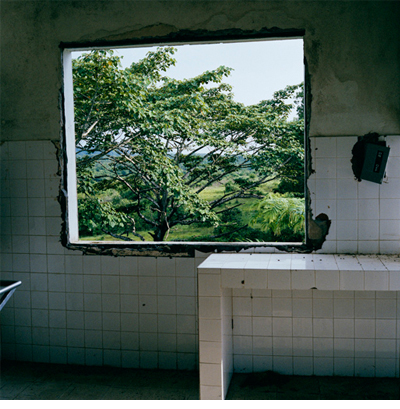
Tim Hetherington Untitled, Liberia, 2003 Digital C-print © Tim Hetherington, Courtesy Yossi Milo Gallery, New York


At the time of his death, in a Libyan mortar strike in April of 2011, Tim Hetherington was one of the most well-known and respected conflict photographers working. This was due in part to his role as co-director on Restrepo, the 2010 documentary that followed the day-to-day life of an American platoon in Afghanistan in immediate, intimate detail.
But Hetherington was entrenched in more than filmmaking, and more than Afghanistan’s fighting. His approach to photojournalism meant pushing the boundaries of image-making, and working across several types of new and digital media to build a more communicative message. But as grand a scale as he worked on, Hetherington’s project was always to immerse the viewer in an individual’s story. His larger body of work—photographing civil war in West Africa, a short film, portraits, interviews, and firsthand accounts of life in war zones—depends on that same depiction of the personal used so grippingly in Restrepo.
The first major exhibition of Hetherington’s photographs, opening at the Yossi Milo Gallery in April, spans his short and extraordinary career. Protagonists appear from all sides, and at all moments in the day life. Liberian women juggle babies and handheld missiles. American soldiers sleep in one photo and wrestle in the next. Hetherington was adept at catching the beauty of these terrains and the bleakness of a war zone in the same frame. This makes for compositions both aesthetically gorgeous and emotionally volatile, and a collection of work that offers as many moments of peace as it does conflict. Hetherington’s legacy will be his gift of seeing the whole picture.
Slideshow
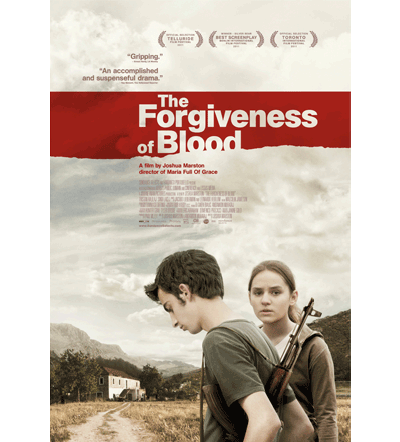


For his first film Maria Full of Grace, Joshua Marston teased an uncompromising and sincerely delicate story out of the world of Colombian drug trafficking, and won himself a slew of international awards in the process. Eight years later, his follow-up deals in a subject no less morally ambiguous. The Forgiveness of Blood asks what happens when two Albanian teenagers are drawn into a blood feud by their father, who may or may not have killed a man. Now according to Albanian social code, the family owes a life, and teenage siblings Nik and Rudina must put their entire lives on hold. The most jarring thing about these events is not the lengths the children must go to, or even the fact that all this is enforced by nothing but social code, with no state law to back it up. The real shock is that Nik and Rudina are modern-day Albanians bowing to a custom that’s hundreds, if not thousands, of years old.
Shot on location from an entirely Albanian script, Marston recruited a cast of non-professional actors and stayed close to the land to raise some essential questions. To what extent are we responsible for the actions and beliefs of our families? What is the “right” retribution for murder? And how long will this ancient practice survive?
CE: Why Albanian blood feuds?
JM: I think the thing that’s fascinating about the blood feuds was more the contrast of the old and the new in Albania. Specifically the idea that someone, a kid, could be sitting in his house playing video games and sending text messages, but the reason that he’s in his house is that he’s stuck in a feud because of this old, ancient tradition.
(more…)
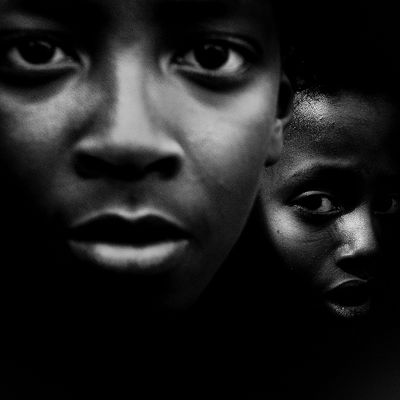
All photographs by Lee Jeffries

Lee Jeffries’ portraits of the homeless are neither documentary photography nor the kind of detached, quick-fire street photography practiced by artists like Weegee. Each photo begins as a conversation, in which Jeffries approaches a person living on the street and simply attempts to get to know him a little better. It’s an everyday gesture, but one that most people would never make—and one that informs the resulting portrait tremendously. Jeffries’ photos, with their lyrical surfaces and intimate framing, make for one of the medium’s most empathetic and affecting tributes to a group of people who remain either de-humanized or flat out invisible in the public discourse.
Jeffries began the project in 2008, back when he still counted himself an amateur photographer, and since then has only expanded its reach. In addition to his native England, he’s shot the homeless populations of Rome, Paris, New York, Las Vegas, and, several times, Los Angeles. His first book of the portraits, Just Talkin’, is a non-profit publication that donates all its proceeds to charity. We spoke to Jeffries as he finishes his latest collection, a series on the homeless people of Miami.
Slideshow
(more…)
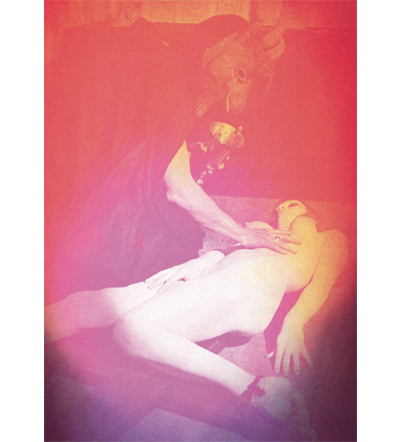

For Julien Langendorff, the seventies never really went away—heavy metal, spiritism, violence-tinged pornography, and a growing consciousness of the world outside the body are all still pressing concerns. Langendorff’s imagery comes from the far-reaching, contradictory world of 1970s subculture, mixing psychedelia’s rainbows and galaxies with BDSM pinups. However, the minimal collages often employ just two photographs, torn and joined in exactly the right place to create a precise juxtaposition. A sculpted angel and a porn actress mirror each other’s poses perfectly. A skull and a planet, exactly the same size, orbit each other. Body parts are replaced with clouds of stars.
The visual rhythms serve as a greater force that holistically links the small and the large, the physical and the spiritual. Langendorff leaves his edges ragged and his placement on the page seemingly haphazard, in order to present his work as low-key and handmade: the result of a momentary idea, an unremarkable and entirely organic occurrence. These images, he posits, are more relevant and interconnected than we think. With almost Zen-like composure, the work suggests that no group of concerns, no aesthetic, could possibly intrigue so many people and still be considered “counterculture.” His show Goddess Fuzz Fantasy will open at agnès b. Galerie Boutique on February 11th.
Slidehsow

Photo by Ruvan Wijesooriya

This Thursday the best in Swedish music, art, and innovation comes together in Dumbo, of all places. The Galapagos Art Space will host Sweden Under the Bridge, an intimate acoustic event with performances by Nina Persson (a Cardigans alumna) and Nathan Larson, indie favorite Fibes, Oh Fibes! and up-and-comer Sibille Attar. The concert is in conjunction with a combined exhibition of contemporary photography from Lars Turnbjörk and Ruvan Wijesooriya, a video installation by Roxy Farhat, and digital art by MOCH. Some of Sweden’s famed djs will pick up where the concert leaves off. Entrance is free and an RSVP is necessary.
Slideshow
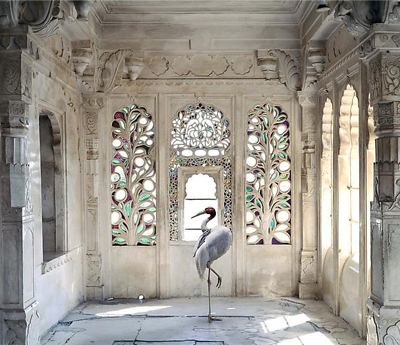
All Images by Karen Knorr. A PLACE LIKE AMRAVATI. UDAIPUR CITY PALACE.


Karen Knorr has built a career out of examining our most opulent places: châteax, English gentlemen’s clubs, grand museums, and her own lavish childhood home. Knorr details the beauty of the finest architecture and ornament, but luxuriating in the grandeur isn’t the point. Knorr fills her rooms with occupants that belie the established respectability and dominance of such seats of power. Tweed-clad men representing the English landed gentry stand idle on their rolling grounds, at a loss amidst so much wilderness. A naked woman lounges on a museum floor, daring tourists to find her naked body obscene among its million painted counterparts. Lately, Knorr has been using animals as the unlikely inhabitants of castles and academies. Using a time-consuming digital process she calls “photoweaving,” Knorr slips giraffes and leopards into the elite’s most carefully molded, supposedly controlled interiors, rendering centuries-old monuments to human hierarchy instantly ephemeral. Though her work was initially grounded in her European roots, she carries her concerns overseas in her latest series, India Song. Knorr spoke with us from outside of Hampi, in southwest India.
Slideshow
(more…)
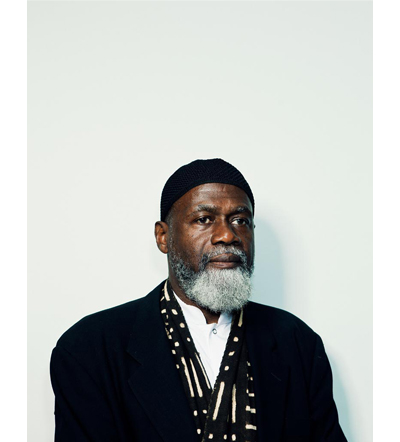
Imam Abdul by João Canziani

For photographer João Canziani, documenting Occupy Wall Street goes beyond photographing protestors. His NinetyNine Portraits, taken over the course of two days in October before Zuccotti Park was forcibly cleared by the police, is a depiction of the phenomenon of Occupy rather than the demonstration. Canziani’s camera moves fluidly between campers, the tourists who gawk at them, the cops who surround them, and the bankers who pass them twice a day. This is the real 99%, a microcosm that didn’t self-select. The portraits are vividly lit and often disarmingly candid, but they come with no identifying label or context. Whatever you guess about the subjects comes from their faces, not their slogans.
How is Ninetynine Portraits different from your previous work?
I usually don’t get very political. My personal has often been “personal.” As in something I want to learn more about myself, my family, or the places I grew up in. And I’m also a contrarian at heart, so I strive to not do what I feel everybody else is doing. But in this case I felt I had a viewpoint that was different from everybody else’s, and something that was new to me.
Slideshow
(more…)





 Facebook
Facebook Permalink
Permalink Digg
Digg Reddit
Reddit LinkedIn
LinkedIn StumbleUpon
StumbleUpon Tumblr
Tumblr












